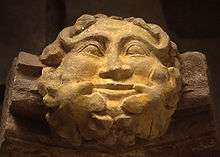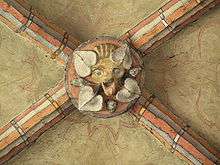Boss (architecture)
In architecture, a boss is a knob or protrusion of stone or wood. Bosses can often be found in the ceilings of buildings, particularly at the keystones at the intersections of a rib vault.[1] In Gothic architecture, such roof bosses (or ceiling bosses) are often intricately carved with foliage, heraldic devices or other decorations. Many feature animals, birds, or human figures or faces, sometimes realistic, but often grotesque: the Green Man is a frequent subject.
A different sense of boss was also an important feature of ancient and Classical construction. When stone components were rough-cut offsite at quarries, they were usually left with bosses (small knobs) protruding on at least one side. This allowed for easy transport of the pieces to the site; once there, the bosses also facilitated raising and/or inserting them into place. An excellent extant example of such bosses can be seen at the Greek Doric temple of Segesta, at which construction was never completed. The bosses of several key elements of the temple, notably the crepidoma, remain as a testament to the construction process.
Gallery

 Early English roof bosses in Salisbury Cathedral, England
Early English roof bosses in Salisbury Cathedral, England Green Man roof boss from Dore Abbey, Herefordshire, England
Green Man roof boss from Dore Abbey, Herefordshire, England The nave of St. Mary Redcliffe church, Bristol, England. Some of the thousand gilded roof bosses can be seen
The nave of St. Mary Redcliffe church, Bristol, England. Some of the thousand gilded roof bosses can be seen- Bosses at Hereford cathedral (England)
- Bosses at Worcester cathedral (England)
- Bosses at Worcester cathedral (England)
 Bosses at Barcelona Cathedral (Spain)
Bosses at Barcelona Cathedral (Spain)- Griffin boss at Cadouin Abbey (France)
- Veronica's veil boss at Cadouin Abbey (France)
- Madonna and child boss in Germany
- Bosses at Jerónimos Monastery (Portugal)
- Boss on St Mark's Cross, Blessington (Ireland)
See also
References
External links
| Wikimedia Commons has media related to Bosses. |
